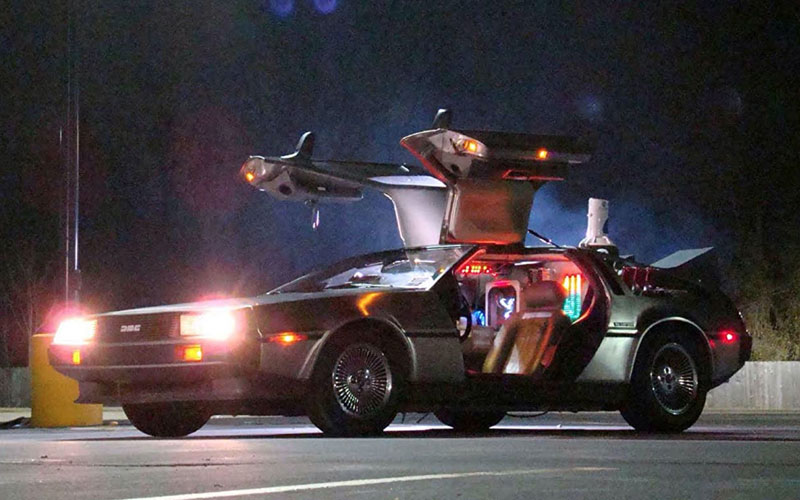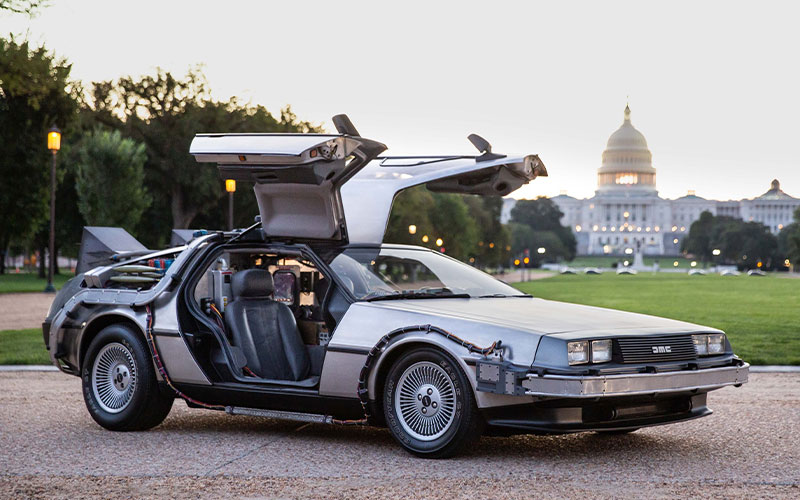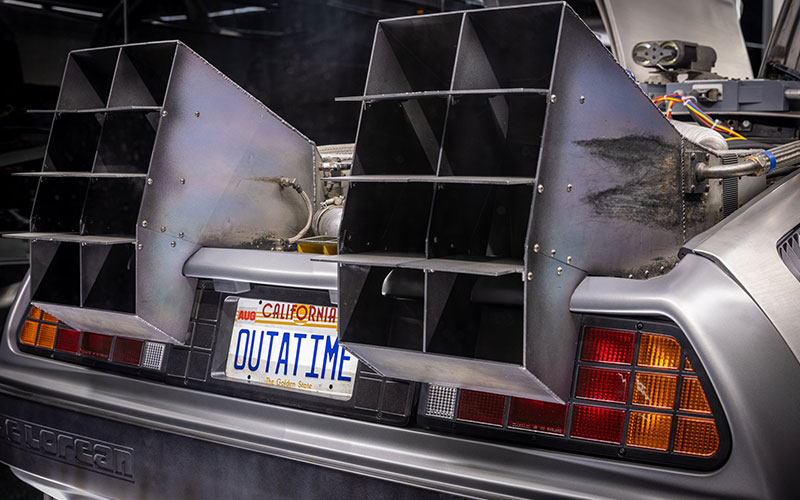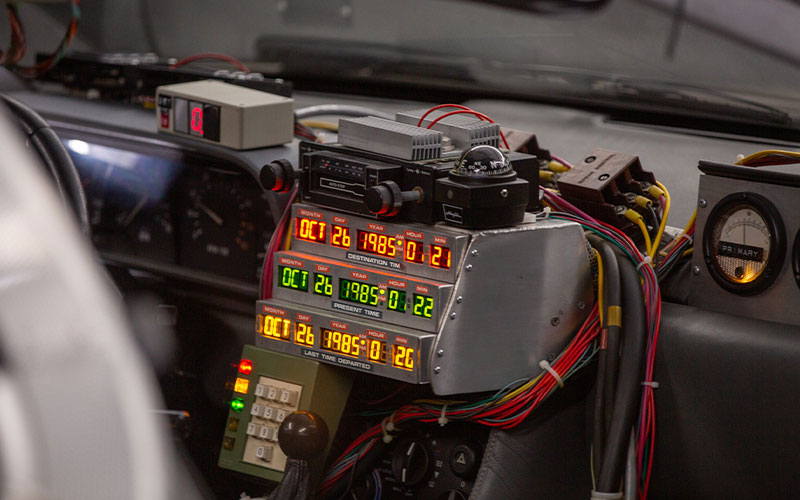The Story Behind the Back to the Future Car
If looking the part is half the battle, the DeLorean DMC-12 was the only logical choice to play the infamous Back to the Future car.
From Zero to 88 mph

While it’s Michael J. Fox and Christopher Lloyd that get top billing in Back to the Future, it’s hard to argue the movie’s biggest star ended up being Doc Brown’s time machine built from a DeLorean DMC-12. Indeed, our list of the best movie cars of all time wouldn’t have been complete without the Back to the Future car. Today, the Back to the Future trilogy is beloved by multiple generations of film fans, and the DeLorean time machine itself has inspired a devoted underground of superfans who have poured countless hours and resources into building their own painstaking replicas. The story of the Back to the Future car is at turns weird and heartwarming.
The Time Machine Template

The weirdness begins with John DeLorean and the DMC-12. DeLorean had been a hot shot executive at GM in the late 1970s. And with successes under his belt that included the Pontiac GTO, DeLorean was steadily rising in the corporate ranks. But his jet-setting playboy lifestyle rubbed some in the company the wrong way. Despite being the odds-on favorite for an eventual CEO position, DeLorean left (or possibly was forced out of) GM to start his own carmaker, the DeLorean Motor Company.
The company’s sole car, the DMC-12, was much like its creator, bold and brash and also perhaps less than it appeared to be at first glance. The car was to have a stainless-steel body, a mid-engine design, and gullwing doors. Compromises on the design and production problems meant the DMC-12 might have looked like a world-beating sports car of the future, yet in reality it was anything but. In an effort to find suitable tax breaks to starting such a venture, DeLorean had turned to no less likely a place for manufacturing his car than Northern Ireland, right in the midst of the sectarian conflict known today as “The Troubles.”

Sales were poor and quality was low. With the company’s finances on the ropes, DeLorean had gotten a call from a neighbor asking if he would like to enter into a little cocaine venture to help with his well-publicized money problem. This turned out to be a drug enforcement sting operation; and while DeLorean was eventually acquitted on grounds of entrapment, his company was forced to file for bankruptcy.
Making Movie Magic

At around the same time that John DeLorean’s project was foundering, two young Hollywood filmmakers were busy writing the script to a new movie with the working title of “Doc Brown’s Time Machine.” Initially, Bob Gale had envisioned the kooky scientist’s DIY time machine would be fashioned from a refrigerator. His writing partner, Robert Zemeckis (fresh from his successful Romancing the Stone) had the idea that a mobile time machine would work better in the film and landed on the DMC-12 as the perfect candidate.
Once the film was green lit, the process of designing and building Doc’s time machine began under the direction of Lawrence Paull (who’d done production design on Bladerunner). Storyboard artist Andrew Probert drew up concept art for the Back to the Future car. But the car didn’t yet have the look of something Doc Brown would have built in his garage. Additional concept work was done by Ron Cobb, special effects consultant Mike Fink, and Mike Schaffe, who oversaw the construction of the car.

They added and embellished bit here and there as they built. They pirated all manner of automotive and electronic parts for the build, making frequent stops to Apex surplus electronics for parts. One notable Easter egg is the use of a Dodge Polara hub cap as part of the housing for the nuclear reactor. Schaffe said they were trying to thread the needle between making the car look both goofy and believable at the same time.
For the first film, three cars were built. The A car, or hero car, would be used for principal photography. The B car was intended for stunt work and exterior shots. And while usually a B car wouldn’t be as elaborately built up as the hero car, the intricate details of the Back to the Future car meant even the stunt car had to be nearly as complete as the A car. Because the DMC-12 had a cramped cabin, filmmakers were forced to chomp up the third car and mount a camera in the front trunk for many interior shots.
Doc Brown’s Time Machine

There are many interesting details to the Back to the Future car (just anyone who’s embarked on building a replica). Among the detail in the build was the speedometer, which in the DMC-12 only went up to 85 mph. Since Doc Brown’s time machine needed to achieve 88 mph for time travel, rather than change the script, filmmakers replaced the speedometer with one that went up to 95 mph. Another cool detail was the OUTATIME vanity plate, which was replaced with a barcode after Doc’s time traveling to 2015.
The nuclear fusion reactor that powers the time machine originally ran on plutonium, which Doc Brown stole from Libyan terrorists (don’t ask). This power source was replaced following Doc’s visit to the year 2015 by a Mr. Fusion Home Energy Reactor (built from a coffee grinder). Though the Mr. Fusion ran on ordinary household garbage, it was still able to provide the 1.21 jigawatts (technically gigawatts) of power needed.

The time circuits are another important component. They’re set to indicate the target time, present time, and prior time traveled from. All vitally important bits of information from time travel. The circuits get damaged in the sequel, sending Doc back not to 1985 but to 1885, thereby necessitating a third movie.
The flux capacitor is the heart of the time machine. As the DeLorean nears the critical 88s, the flux capacitor flashes and flickers. A Dymo label expresses says, “shield your eyes from the light.” Though Doc is interrupted by Libyan terrorists (again, don’t ask) before he can explain to Marty how exactly the flux capacitor works, he does mention that the stainless-steel body panels “improves the flux dispersal.”

For those who dream of building their own DeLorean time machine, there’s even a book, just published this past March, Back to the Future DeLorean Time Machine: Doc Brown’s Owner’s Workshop Manual written by the original screenwriter Bob Gale and Joe Walser the leading authority on the DeLorean time machine (he even did the restoration of the original A car for Universal Studios).
Whether you’re a Back to the Future superfan or just nostalgic for Marty and Doc’s time traveling misadventures, we know you’ll never forget the DeLorean.









